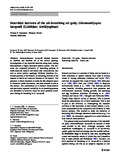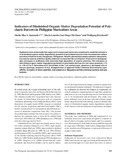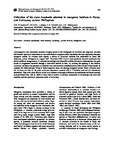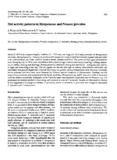Intertidal burrows of the air-breathing eel goby, Odontamblyopus lacepedii (Gobiidae: Amblyopinae)
Share
ບົດຄັດຫຍໍ້
Odontamblyopus lacepedii inhabits burrows in mudflats and breathes air at the surface opening. Investigations of the intertidal burrows using resin casting demonstrated a highly branched burrow system. The burrows are composed primarily of branching patterns of interconnected tunnels and shafts that communicate into two to seven surface openings. Bulbous chambers (i.e., dilated portions of the burrow) at branching sections of the tunnels or shafts are common features of the burrow. The presence of these chambers accords the fish adequate space to maneuver inside the burrow, and thus constant access to the surface. The combination of all burrow characteristics and previously reported variability in air breathing patterns are ostensibly of selective value for aerial predator avoidance during air breathing in O. lacepedii.
Suggested Citation
Gonzales, T. T., Masaya, K., & Ishimatsu, A. (2008). Intertidal burrows of the air-breathing eel goby, Odontamblyopus lacepedii (Gobiidae: Amblyopinae). Ichthyological Research , 55(3), 303-306. https://doi.org/10.1007/s10228-008-0042-5
ວິຊາ
Taxonomic term
Collections
- AQD Journal Articles [1249]
Related items
Showing items related by title, author, creator and subject.
-
Indicators of diminished organic matter degradation potential of polychaete burrows in Philippine mariculture areas
Santander, Sheila Mae S.; San Diego-McGlone, Maria Lourdes; Reichardt, Wolfgang (University of the Philippines Los Baños, 2008)Sediments from underneath fish cages and in mesocosm tanks were examined to establish indicators of diminished organic matter degradation potential of polychaete burrows from increased mariculture activities in Bolinao-Anda, ... -
Collection of the clam Anodontia edentula in mangrove habitats in Panay and Guimaras, central Philippines
Primavera, Jurgenne; Lebata, M. J. H. L.; Gustilo, Lillian F.; Altamirano, Jon (Kluwer Academic Publishers, 2002)The mangrove clam Anodontia edentula is highly prized in the Philippines for its flavor and large size. Because this infaunal species is found down to one meter deep in mangrove areas, harvesting the clam reportedly damages ... -
Diel activity patterns in Metapenaeus and Penaeus juveniles
Primavera, Jurgenne; Lebata, J. (Springer Verlag, 1995)Small (5–10.9 mm carapace length), medium (11–15.9 mm), and large (16–20.9 mm) juveniles of Metapenaeus anchistus, Metapenaeus sp., Penaeus monodon and P. merguiensis were stocked individually in glass tanks provided with ...




